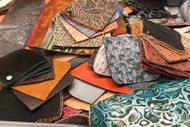The History of Leather and Cowboy Boots
Apr 13th 2020
A Quick History of Cowboy Boots
When it comes to a good, hardy cowboy boot that lasts, can withstand stirrup use, mud, the weather, and everything you encounter on your feet—most people immediately associate leather as the best material for such footwear. Cowboy boots and leather just seems like they naturally go hand in hand. How did this material end up the mainstay of rugged boots? Where did this association come from, and why is leather the go-to choice material for boots? If you've ever wondered where it may have started from like us, here's a fascinating look at the history of leather and how it became identified with our boots.
Prehistoric influence
The use of leather for the construction of clothing and footwear was first recognized in prehistoric times. Early man began to use early forms of leather for clothing and shelter against harsh conditions and climates. Some of the more primal recorded leather artifacts crafted by primeval societies can be dated back to 1300 BC when man realized animal skins could be so much more than a food by-product. Beginning civilizations all started to develop their own techniques to soften as well as preserve animals' skins and traditionally passing that knowledge down through the generations. Sometime during this era, the joining of separate leggings or soles components were joined together to create a single unit: the boot, or boots. Soft leather ankle boots were worn by nomads in eastern Asia and carried to China, India, and Russia around 1200 to 1500 AD. Early Dutch Masters were the first to define the boot in European iconography despite the fact many civilizations were using different forms of boots for centuries.
It is believed the first discovery of using vegetable tanning to preserve was discovered by ancient Hebrew settlers.
Ancient Greeks were known to use leather for sandals and other garments, while the prevalence of leather manufacturing spread to Egypt and later to Rome where it was commonly used by foot soldiers to create protective over-shirts and other items for their armory.
The industry and techniques used to craft, shape and use leather continued to grow. The 18th century saw many uses for leather such as machinery belts, automobile interiors, and footwear. But it wasn't until the 19th century that alternative methods to vegetable tanning were invented. Chrome tanning involved the use of chemicals which streamlined the manufacturing process so that many of the long, arduous steps of preparing traditional vegetable tanning were eliminated. This method is still used today, where 80-90% of tanning worldwide still involves the use of chromium.
America, The Vaquero, and the Horse.
Influences from the Vaquero traditions of northern Mexico can be found with the wrangler, the horse-riding cattle rancher, and the rodeo. Equestrian life has been part of human history for centuries and riding boots have been an important part of that history. The very earliest cowboy boot, or riding boot, was first influenced by the Vaquero imported into American traditions and military boots designed for Calvary riders.
Many historians find it difficult to pin-point the exact time leather became associated with cowboy boots and working boots in America. Historically, however, it's widely known that horsemen and women have always needed protective footwear as well as a boot with a heel.
One of the origins of the cowboy boots today comes from a style called the Wellington boot, originating from Britain's Duke of Wellington. At that time in history, the Wellington boot was a plain, straight leather booth with one-inch heels and straight tops. There was also the Hessian boot, which had a distinctive V-cut in the front of the boot. Coffeyville-style boots began in Coffeyville, Kansas approximately around 1870 and were normally black leather with a low Cuban heel. The front of this boot, known as the graft, was higher than the back and Texas cowboys who adopted the style at the time were known to inlay a lone star in the graft.
From there and throughout the late 1800s, cowboy boots and their designs were influenced by European cavalier styles of boot that had higher heels and better-quality leather. The cowboy boots and most boots of this time were square-toed or rounded. It wasn't until the 1950s that cowboy boots unique pointed toe was implemented.
While some work boots developed heavy treads to combat slipping haphazards, a cowboy boot's slick, treadless leather sole allowed the easy transition of insertion and removal of foot into stirrups of the Western saddle. The heel of a cowboy boot prevents the heels of the foot from sliding through the stirrup, which could turn out to be life-threatening if the rider were to be unseated. Even to this day, becoming unseated while horseback riding is a very real, serious threat.
So why did leather become a mainstay?
Leather is one of the most popular, and most versatile natural materials for hardy, long-lasting boots.
But there are other important benefits as well. Leather is a completely breathable, elastic, tear-proof, abrasion-resistant, heat-insulating, supple material. Boots made from leather offer a unique combination of sturdiness and style all at once. Leather boots can allow the wearer to get messy, plunge through the mud, walk through brushes and thorns, and even repel a rattlesnake bite if wearing cowboy boots! And, anyone who owns a pair of leather made boots can tell you that they offer the optimum of comfort along with all these added benefits. Leather's flexibility allows coziness and insurance against weather and accidents while still allowing the foot to move freely.
Given these benefits paired with the antiquity of leather and boots, wearing your own pair is like wearing a piece of American culture and history! It's no wonder leather became a mainstay for boots.

